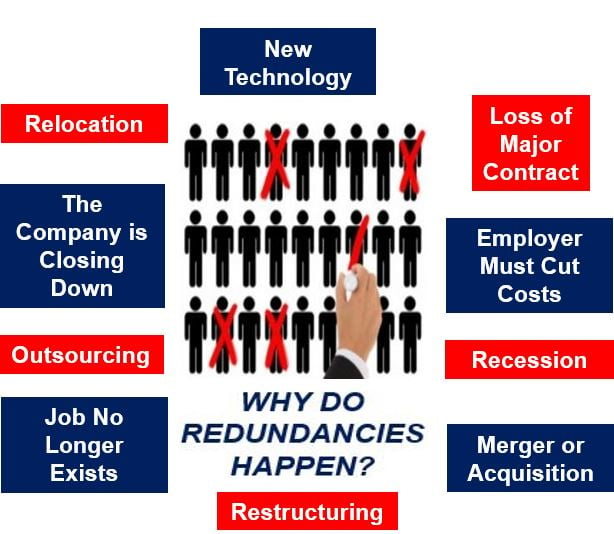Who Pays Redundancy Money? A Comprehensive Overview for Companies and Employees
Who Pays Redundancy Money? A Comprehensive Overview for Companies and Employees
Blog Article
Checking Out the Interaction Between Company Redundancy and Organizational Adaptability for Future Growth
In the dynamic landscape of today's service globe, the detailed partnership in between company redundancy and business versatility arises as an essential factor for continual growth and success. Business usually encounter the obstacle of striking a fragile balance in between maintaining a degree of redundancy to mitigate dangers and promoting flexibility to react swiftly to the ever-evolving market demands. This delicate interaction holds the key to not only surviving in rough times however additionally prospering despite uncertainty. As we explore the multifaceted dimensions of this interplay, appealing understandings into just how companies navigate these intricacies to pave the method for future development await.
Relevance of Firm Redundancy
Firm redundancy is a critical component that enhances organizational strength and reduces functional dangers. By incorporating redundancy procedures within the organizational framework, firms can better stand up to unexpected disruptions and variations in the organization environment. Redundancy offers as a strategic buffer, allowing firms to adapt and react successfully to unexpected difficulties without compromising important procedures.
One key facet of the relevance of firm redundancy is its role in making sure connection throughout times of crisis. When confronted with sudden modifications or emergencies, redundant systems, sources, or personnel can action in to maintain critical functions and stop extensive disturbances. This connection not only safeguards the business's track record and consumer trust yet additionally minimizes economic losses and functional downtime.

Approaches for Organizational Flexibility

Creating versatile business structures that allow for fast changes to market characteristics and consumer demands is vital for remaining competitive in a rapidly developing environment. By proactively identifying possible disturbances and opportunities, organizations can proactively adjust and flourish in an ever-changing service landscape.
Harmonizing Redundancy and Flexibility
Achieving a harmonious stability between operational redundancy and organizational versatility is extremely important in navigating the complexities of a dynamic organization environment. Striking the best equilibrium in between redundancy and flexibility is a delicate procedure that calls for a deep understanding of the company's goals, market dynamics, and risk resistance.
To attain this equilibrium, companies need to carry out routine assessments of their procedures to determine locations where redundancy is necessary for danger reduction and where flexibility can drive advancement and development. Executing adaptable frameworks, cultivating a society of constant learning and renovation, and urging open communication across all levels of the company are vital strategies to balance redundancy and flexibility efficiently. By aligning these 2 critical components, firms can position themselves for sustainable development and success in an ever-changing service landscape.
Study on Adaptation Success
In taking a look at circumstances of successful business adaptation, it becomes obvious that the interaction in between functional redundancy and adaptability is a defining aspect in forming resistant companies. One compelling study is that of Netflix. Initially a DVD rental solution, Netflix demonstrated exceptional flexibility by Your Domain Name transitioning right into a streaming platform when digitalization disrupted the sector. By tactically purchasing modern technology and material production, Netflix not only thrived however survived in a rapidly developing market. An additional standout example is Amazon. Beginning as an on-line bookstore, Amazon continuously adjusted its business model, broadening into varied sectors such as cloud computing and synthetic intelligence. This versatility permitted Amazon to stay ahead of rivals and satisfy altering customer demands. Finally, Adobe offers a significant image of effective adjustment. The business shifted from marketing software licenses to a subscription-based version, ensuring reoccuring profits streams and enhanced client engagement. These study highlight the value of functional redundancy coupled with organizational flexibility in fostering long-lasting growth and competition.
Building Durability for Future Development
Structure strength for future development needs a calculated positioning of operational procedures with market characteristics and emerging trends. Business should adjust to changing settings by cultivating a culture of flexibility, technology, and continual renovation.
Furthermore, promoting strong partnerships with stakeholders, such as customers, employees, distributors, and the community, is vital for preserving and weathering uncertainties trust fund and support during rough times. Effective interaction and transparency play a vital duty in building resilience, as they aid align assumptions and assist in partnership in navigating unpredictabilities.
Additionally, companies require to prioritize learning and development efforts to upskill staff members and equip them with the this post needed devices to adjust to altering circumstances. By buying their labor force, companies can improve their adaptability and dexterity, inevitably reinforcing their resilience for sustainable future growth.
Final Thought

In the dynamic landscape of today's organization world, the detailed relationship in between company redundancy and business flexibility arises as a vital variable for sustained growth and success. Firms often deal with the difficulty of striking a delicate equilibrium in between maintaining a level of redundancy to alleviate dangers and cultivating flexibility to react swiftly to the ever-evolving market needs.To attain Web Site this balance, companies need to conduct normal assessments of their operations to recognize locations where redundancy is essential for threat reduction and where versatility can drive advancement and growth.In final thought, the interaction in between company redundancy and organizational versatility is essential for future growth. Building strength through a mix of redundancy and flexibility will ensure that firms are prepared for the challenges of the future.
Report this page